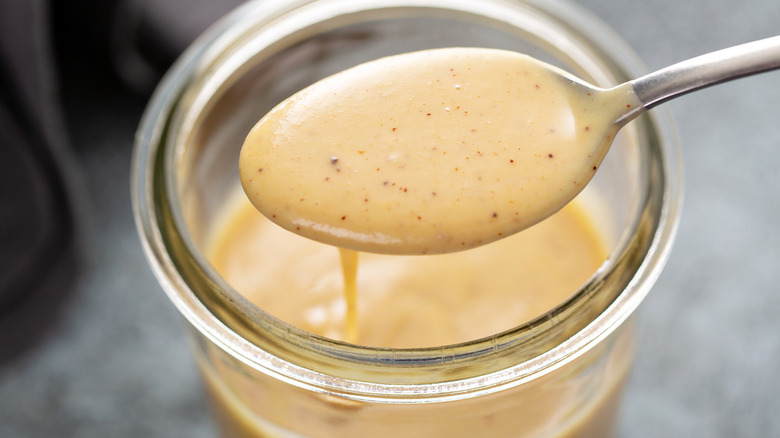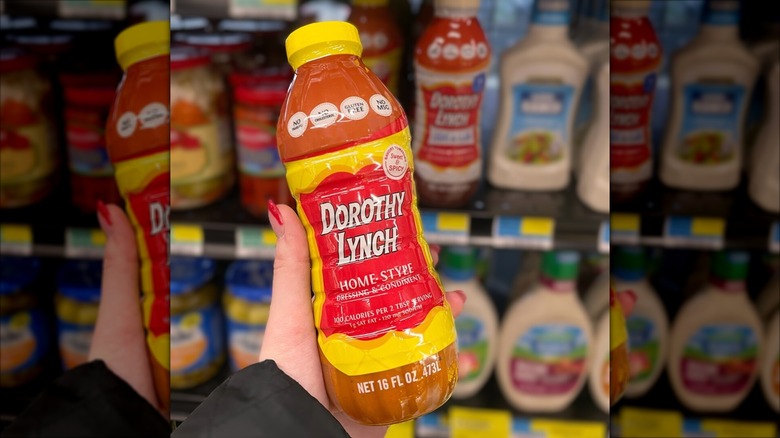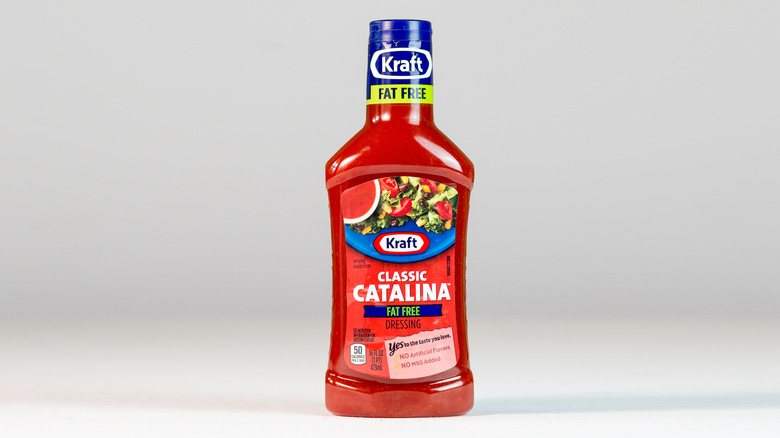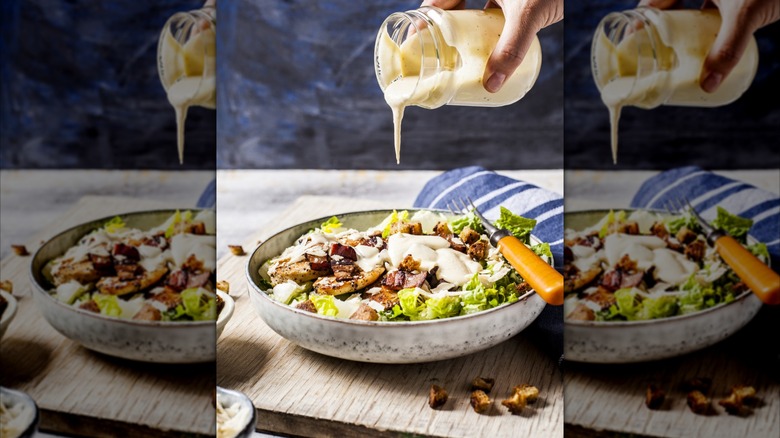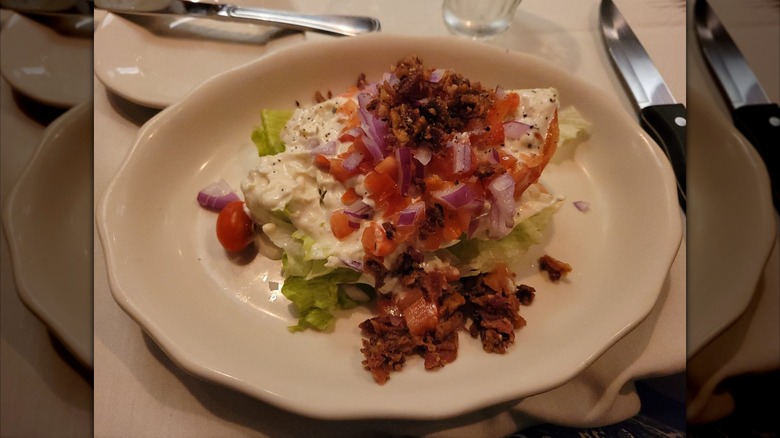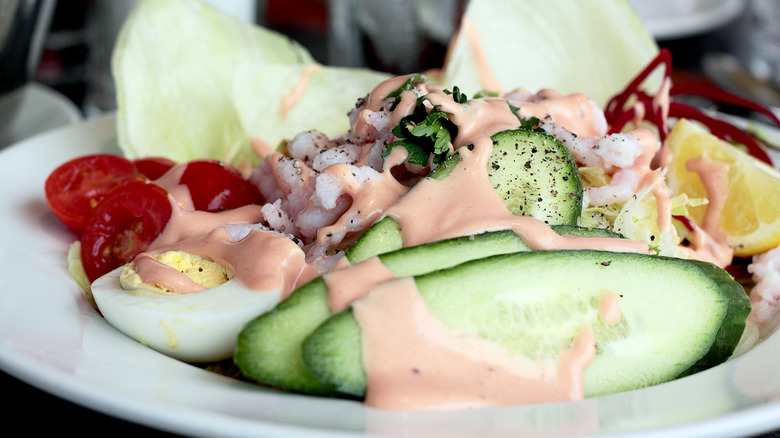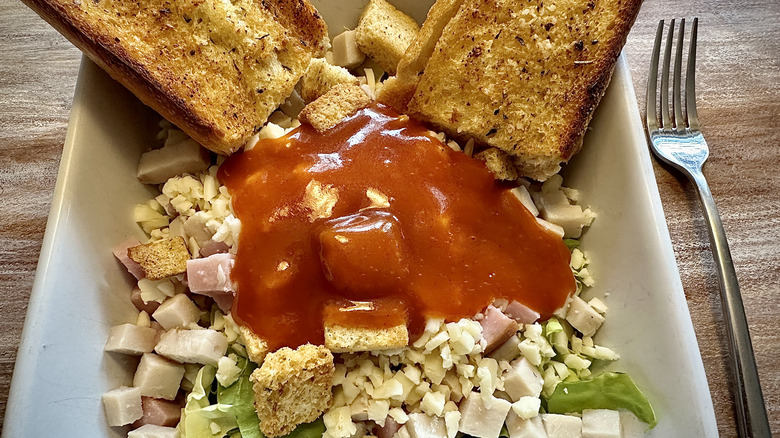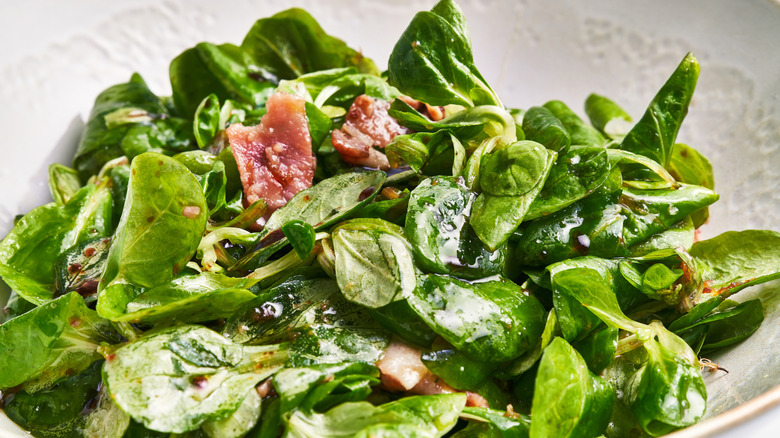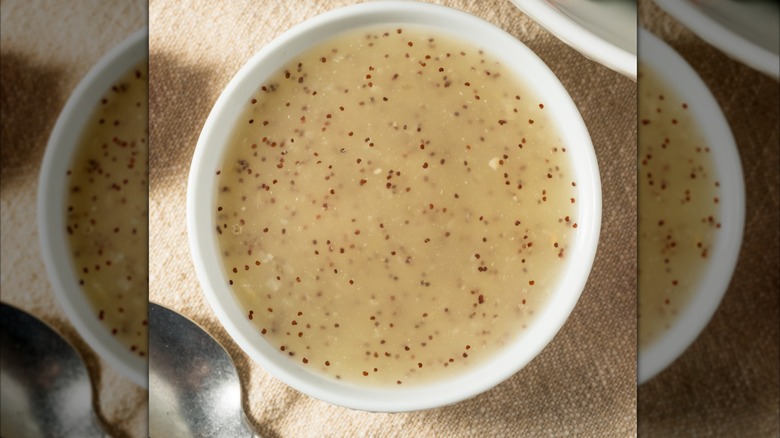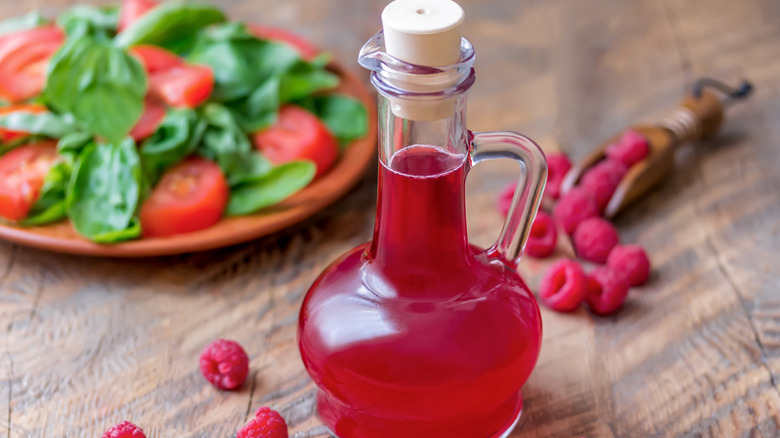12 Old-School Salad Dressings That Aren't As Popular Anymore
Salad dressings seem simple on the surface. After all, the easiest of salad dressings is merely oil and vinegar, two ingredients that have fed humans for millennia. However, peruse the salad dressing aisle at your local grocery store and you'll quickly realize that, while you may have the two or three favorites that you eat on repeat, there are actually quite a few different dressing options out there.
Additionally, salad dressings boast a rich history. The ancient Babylonian and Egyptians were coating their leafy greens with oil and vinegar. Fast forward to the Middle Ages and European royals were eating salads dressed in oils and herbs. Supposedly, Mary Queen of Scots liked a creamy mustard dressing, and King Henry IV liked an herby dressing for his potato salad made with sardines. Fast forward through history again and you get the advent of bottled salad dressing, with options from Joe Marzetti and Kraft making their ways to the American salad bowl in the early half of the 20th century.
However, while salad dressings have retained their appeal (after all, there's nothing worse than a dry bowl of lettuce), not all varieties have stood the test of time. While some have become ubiquitous, part of American culture (ranch dressing, anyone?), others have fallen out of public favor, reduced to become mere regional favorites or not even that. Here are some old-school salad dressings that just aren't as popular anymore.
Dorothy Lynch dressing
You can still buy Dorothy Lynch dressing if you're willing to make a trek out to Nebraska, or if you're cool with paying for the necessary shipping and handling to have a bottle mailed to you. However, when many Midwesterners think of Dorothy Lynch dressing, they do so with a sense of nostalgia, noting that it was a popular salad dressing for basic house salads before ranch dressing became the go-to.
So what is it? Before you can describe what Dorothy Lynch dressing is, you have to know who the dame behind the dressing was. Dorothy Lynch lived in St. Paul, Nebraska, in the 1940s, where she and her husband ran a Legion Club restaurant. She made the restaurant's salad dressing herself, and it became so popular that people wanted to buy it, spurring the founding of the Dorothy Lynch brand.
The creamy red dressing's primary ingredient is tomato soup, followed by sugar, oil, vinegar, salt, and spices (alongside the requisite preservatives and natural flavorings). It's described as sweet and spicy, and nothing at all like French dressing, even if the appearance might be similar. If you get your hands on some Dorothy Lynch dressing, there are myriad ways you can use it beyond topping a salad, but Midwesterners remember eating it on a simple combination of iceberg lettuce, cheddar, diced ham, and club crackers.
Catalina dressing
Just as Dorothy Lynch dressing may be incorrectly presumed to be just a French dressing knock-off, so is Catalina dressing sometimes compared to French dressing. However, just because these condiments are similar in appearance, they still differ in their unique ways.
Kraft's creamy French dressing is made up primarily of soybean oil, high fructose corn syrup, water, and vinegar. Seasonings like dried garlic and paprika are added to a lesser degree, and the paprika is just there for color. Meanwhile, Kraft's Catalina dressing (which is great on tacos) contains real sugar instead of high fructose corn syrup, as well as tomato puree (some recipes for homemade Catalina dressing include ketchup instead), plus vinegar and oil. Additionally, while French dressing has a long, long history, Catalina dressing is apparently a Kraft invention of the 1960s. Some do theorize that it has roots in the Catalonia region of Spain, but there's not really any evidence of that.
So whatever happened to Catalina dressing? While you can still buy it, it doesn't really have the same grip on American salads as it once did. You can find people reminiscing about it on social media, recalling days when you could easily find not just original Catalina dressing, but different variants such as Western Catalina dressing or Catalina with bacon. The Catalina dressings of today, some say, just don't taste the way they once did.
Boiled salad dressing
Even if you've never made salad dressing from scratch, and always opt for the store-bought, bottled variety, chances are likely that you know that making salad dressing doesn't require turning on the stove ... right? Last time you checked, all you need to do is whisk together some ingredients? At most, you might need to chop some herbs?
Don't worry. You haven't been in the dark about how to make salad dressing all this time. Most homemade salad dressings do come together with just a bit of whisking. However, in decades past, home cooks may've pulled out a saucepan and turned on their stoves if they needed a dressing. Boiled salad dressing was a Southern staple that required cooking a mixture of ingredients using the double-boiler method. One would mix all the ingredients (often including flour, raw eggs, and pantry staples for flavor such as mustard, vinegar, and/or pepper) and then allow them to cook over boiling water. The result was something that was kind of like a salad dressing, kind of like a mayonnaise, and kind of like a hollandaise sauce. What makes the dressing recipe really stand out, though, is that it requires no oil. This fact would've made it desirable for those who couldn't get their hands on expensive or otherwise unavailable oil.
Want to try a boiled salad dressing, but still don't want to turn on your stove? Some compare boiled salad dressing to Heinz salad cream.
Mayfair dressing
Like Dorothy Lynch dressing, Mayfair dressing has deep regional roots, but while everyone can agree that those roots lead to St. Louis, it's not entirely clear who planted those roots to begin with. Some say the Mayfair salad was introduced at the 1904 St. Louis World's Fair Exhibition. Others note that the salad was named for the Mayfair Hotel in St. Louis, as it was created by a chef who worked there. However, these stories don't quite line up, as the Mayfair Hotel didn't open until 1924. Still others credit additional individuals at the hotel for the salad's invention, such as a head waiter or the son of the hotel's founder, at different points in history, ranging from the 1930s to the 1950s.
Whatever the case, you can still order the Mayfair salad – with Mayfair dressing — at the Magnolia Hotel in St. Louis, which was what the Mayfair was eventually rebranded as. At the hotel, the salad simply consists of romaine lettuce, cucumbers, red onion, tomato, diced ham, and swiss cheese, along with the Mayfair dressing, of course.
Mayfair dressing is often likened to Caesar dressing, but with a few flaws, namely an odd texture created by the inclusion of raw celery and onion. Otherwise, the dressing includes homemade mayonnaise, anchovies, mustard, pepper, garlic, and lemon juice.
Louie dressing
Seafood Louie is one of those vintage seafood dishes that no one eats anymore, right alongside tuna and waffles (yes, you read that correctly) and shrimp puffs. The "Louie" is a salad, and it can vary, containing a mix of seafood, crab, or shrimp, alongside lettuce and hard-boiled eggs. However, it's the Louie dressing that many agree make the dish what it is (with even James Beard saying so!).
Appearing in cookbooks as early as the 1910s, the initial dressing recipe required a simple mix of oil, vinegar, ketchup, Worcestershire, mustard, paprika, and salt. This recipe, though, is a far cry from what you'll get if you order a seafood Louie at a restaurant today. As the dish grew in popularity over the decades, being served at hotels and restaurants along the West Coast, where access to fresh crab was convenient, the dressing evolved significantly. Sometimes it included olives, for example. Eventually, it came to always basically include mayonnaise, as well as some sort of hot or chile sauce for kick, plus relish. However, it's retained the OG ketchup, Worcestershire, and paprika.
What does a classic Louie dressing taste like? It's been compared to Thousand Island dressing, though with a little more spice and a little less sweetness.
Casino dressing
Like Catalina dressing, casino dressing was a mid-century Kraft invention. This was a time in food history defined by dishes that seem absurd today — like salmon-infused gelatin in the shape of an actual salmon, or casseroles combining hot dogs and corn syrup. In comparison, casino dressing, trademarked in 1951, seems relatively tame.
Marketed as a "gay and spicy" French dressing with the addition of garlic and "exotic" herbs and spices (via Flickr), Kraft recommended buyers pair the bright red casino dressing with pork chops. However, while pairing salad dressing with meat doesn't sound too out of the ordinary — what is a salad dressing if not a potential marinade? — you won't find it among the top ingredients that will give you supremely tender pork chops.
Confusingly, around the same time period, Kraft was also publishing recipes for a casino salad, but that casino salad didn't actually include any Kraft casino dressing. Instead, the Kraft casino salad was a mix of finely chopped beetroot and cheese mixed with mayonnaise, and served alongside more cheese, beetroot, cabbage, and radishes. Yum?
Additionally, there's no through line connecting casino dressing or casino salad with clams casino, either. That dish was thought to be created by a New England resort employee to serve at a luncheon, at which the hostess had requested something special and unique. At least clams casino are much more palatable than a casino salad, combining clams with breadcrumbs and bacon.
Southern Pacific dressing
No, this salad dressing isn't named for the South Pacific. Instead, it gets its name from the Southern Pacific Railroad. Established in the mid-1800s, the Southern Pacific Railroad operated throughout the American West and Southwest, carrying passengers for more than a hundred years. Today, Americans have few options for rail travel and even fewer options that come with an enjoyable dining experience, but that's exactly what you could expect when traveling with Southern Pacific. In fact, dining aboard Southern Pacific's trains was so highly regarded that the company once published a book of dining car recipes complete with little tidbits like "ten don'ts for housewives" (which is really just a list of cooking tips, with no need for the gendering). Within the book, Southern Pacific included the recipe for Southern Pacific dressing, a mixture of mayonnaise, ketchup, currant jelly, mustard, salt, and vinegar.
It wasn't just the Southern Pacific dressing that stood out to rail travelers during this time, though. The salads in general were special, and lines like Southern Pacific and Union Pacific (which was operational at the same time and later merged with Southern Pacific) advertised them specifically. Union Pacific offered individual salad bowl service during its trips and printed recipe cards with its own dressing recipes, and Southern Pacific marketed its "famous salad bowl" with the tagline "help yourself" (per Colorado Railroad Museum). The reason for these salads' fame? It all came down to the newly invented miracle of on-train refrigeration.
Bacon and tomato dressing
In the 1980s, Kraft introduced yet another salad dressing that would eventually fade from the foreground: bacon and tomato dressing. Marketed as being made with real bacon and real tomatoes, as well as sour cream, it became a favorite with ardent followers, who found it to be the perfect addition to a BLT and who are now reduced to making their own copycat versions of the salad dressing by mixing ranch with tomato paste and ground bacon.
But while some get creative in the kitchen, searching for the elusive combination of ingredients to mimic the dressings of the past, others are searching for replacements that already exist on the store shelf. Some have found luck with Duke's smoky bacon and tomato flavored mayonnaise, though it's not exactly useful as an actual salad dressing due to the fact that, at the end of the day, it's still mayonnaise (unless you like mayo on your salads). Others have replaced it with Kraft's tangy bacon Catalina dressing, which makes sense given that Catalina dressing already contains a high volume of tomato; however, others say that Catalina doesn't provide the same creaminess as Kraft's original bacon and tomato dressing.
Hot bacon dressing
Another dressing that relies on bacon (as so many good things in life do), hot bacon dressing was not some corporate invention, like bacon and tomato dressing. Instead, this salad dressing goes much further back, potentially all the way to the 1800s. Before getting into the origins of hot bacon dressing, though, it's important to note that the "hot" in hot bacon dressing relates to the dressing's temperature, not its spice level.
Now that we have that out of the way, where did this dressing come from? Many connect the dressing to the Pennsylvania Dutch, while others say that the dressing is a derivative of one that would have been used in the earliest versions of hot German potato salad. These two connections make sense as the Pennsylvania Dutch actually first settled in America after emigrating from Germany — not the Netherlands (the "Dutch" should actually be "Deutsch," which means "German").
The Pennsylvania Dutch likely added hot bacon dressing to dandelion greens, until the norm became spinach. Whatever you add it to, this old-fashioned dressing is made by cooking and crumbling bacon, whisking your other ingredients into the hot bacon fat, adding the bacon back in, and pouring it all over your salad. The other dressing ingredients might differ from recipe to recipe. Some recipes include shallots, vinegar, mustard, and sugar. Others may leave out the mustard but add in cream and egg (for something similar to the aforementioned boiled dressing).
Poppy seed dressing
While she may've not invented it, per se, cookbook author Helen Corbitt is largely credited with popularizing poppy seed dressing, when she published a recipe for the salad dressing in the 1950s. By that time, she'd become a force in the culinary world. Starting her career in food as a therapeutic dietitian, she went on to teach catering and restaurant management at the University of Texas, and then most notably became a food service director for Neiman Marcus. She invented Texas caviar. Her recipes became popular in the White House. And some home cooks still use her poppy seed dressing recipe today.
The recipe is simple: sugar, dry mustard, salt, vinegar, onion juice, oil, and poppy seeds. Interestingly, while home cooks today may prize olive oil for its supposed health benefits, Corbitt clarifies not to use olive oil in her recipe, opting instead for Wesson, a vegetable oil that would have been marketed as salad oil in the 1950s. Corbitt's recommendation for poppy seed dressing? Put it on a grapefruit, preferably one grown in Texas.
However, while Corbitt spread the love for poppy seed dressing throughout the mid-20th century, today, it doesn't have quite the same fanbase as it once did. While, yes, you can still easily buy it at the grocery store, you're not going to find it among the salad dressings Americans love most.
Raspberry vinaigrette
Raspberry vinaigrette may seem a little ho-hum now — after all, what's so special about raspberry vinaigrette, when you have dozens of other dressing options in the grocery store? — but that wasn't the line of thinking for many when raspberry vinaigrette burst onto the scene like the Kool-Aid Man in the 1980s. Chefs and consumers alike thought that this salad dressing was the height of sophistication, part of an ongoing attention to lighter, chicer foods.
Some claim raspberry vinaigrette's popularity in the 1980s was an extension of the nouvelle cuisine movement that began in France decades earlier, before making its way to the United States; this movement prioritized light, fresh foods, eschewing fatty, sugary, starchy, and salty ingredients. Others point toward the 1982 cookbook "The Silver Palate Cookbook", which sold millions of copies and was regarded as a sign of a refined palate (yes, there's a recipe for raspberry vinaigrette in this cookbook, alongside mentions of other trending ingredients of the day, like arugula and pesto).
However, whatever's to blame for its fame, by the 1990s, many culinarians and restauranteurs recognized raspberry vinaigrette for what it was: a fad. Meanwhile, the average consumer still had access to raspberry vinaigrette via variations created by such brands as Kraft and Newman's Own. Today, you can still buy both brands' raspberry vinaigrettes — but no one is clamoring for them quite like they were in the 1980s.
Roquefort
You may not recognize this retro salad dressing, but you probably are very familiar with its sibling. Roquefort dressing is a type of bleu cheese dressing, but the two are not one and the same. All Roquefort dressings are technically bleu cheese dressings, but not all bleu cheese dressings are Roquefort dressings — and Roquefort dressings are getting more difficult to find, if fans are to be believed.
So what exactly makes Roquefort so special that its fanbase can't just settle for your run-of-the-mill bleu cheese dressing? To start, there are many types of bleu cheese with very different characteristics. In fact, bleu cheese can simply refer to any cheese cultured with penicillium mold. The type of milk used, geography, and more can all impact taste and texture, resulting in bleu Stilton, Gorgonzola, Roquefort, and other varieties.
Roquefort, though, is deemed by many to be the superior bleu cheese. One of the oldest varieties of bleu cheese, it's made from ewe's milk, not cow's milk, and aged in limestone caves, and it's particularly pungent (out of a group of cheeses that specialize in pungency). Additionally, only bleu cheese processed in Roquefort, France, can be labeled as Roquefort. As such, devoted fans point out that, if you can't get real Roquefort dressing, the bleu cheese stuff simply won't do.
